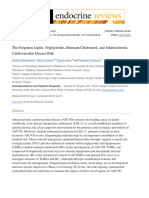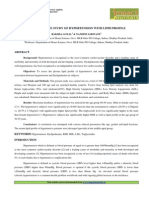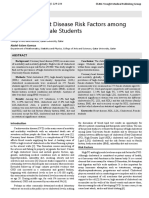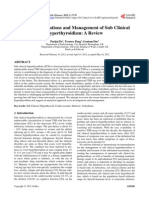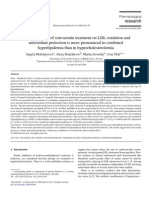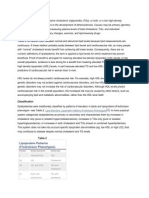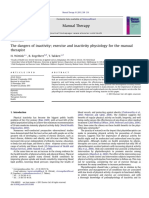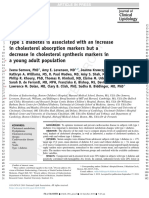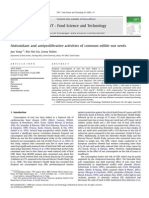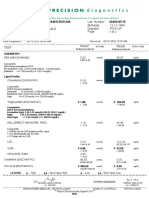Evaluation of Effect of Smoking and Hypertension On Serum Lipid Profile and Oxidative Stress
Evaluation of Effect of Smoking and Hypertension On Serum Lipid Profile and Oxidative Stress
Uploaded by
Aan AchmadCopyright:
Available Formats
Evaluation of Effect of Smoking and Hypertension On Serum Lipid Profile and Oxidative Stress
Evaluation of Effect of Smoking and Hypertension On Serum Lipid Profile and Oxidative Stress
Uploaded by
Aan AchmadOriginal Description:
Original Title
Copyright
Available Formats
Share this document
Did you find this document useful?
Is this content inappropriate?
Copyright:
Available Formats
Evaluation of Effect of Smoking and Hypertension On Serum Lipid Profile and Oxidative Stress
Evaluation of Effect of Smoking and Hypertension On Serum Lipid Profile and Oxidative Stress
Uploaded by
Aan AchmadCopyright:
Available Formats
Asian Pacific Journal of Tropical Disease (2011)289-291
289
Contents lists available at ScienceDirect
Asian Pacific Journal of Tropical Disease
journal homepage:www.elsevier.com/locate/apjtd
Document heading
Evaluation of effect of smoking and hypertension on serum lipid profile
and oxidative stress
Jeeyar1, Hemalatha2, Wilma Delphine Silvia CR3*
Department of Biochemistry, KMCT Medical College, Calicut-673602
Department of Biochemistry, Dr.BR. Ambedkar Medical College, Bangalore-560045
3
Department of Biochemistry, Sapthagiri Institute of Medical Sciences & Research Center, Bangalore-560090, India
1
2
ARTICLE INFO
ABSTRACT
Article history:
Received 18 August 2011
Received in revised form 27 September
Accepted 20 October 2011
Available online 28 December 2011
Objective: To determine the effect of smoking, hypertension individually on lipid profile and
lipid peroxidation and the cumulative influence of smoking and hypertension on oxidative stress
and lipid profile. Methods: Serum total cholesterol, high density lipoprotein (HDL), low density
lipoprotein (LDL), very low density lipoprotein (VLDL), triglycerides and malondialdehyde (MDA)
were estimated in sixty cases including twenty smokers, twenty hypertensives, and twenty
smokers with hypertension and compared with those in twenty age and sex matched healthy
controls. Results: Statistically significant increase in MDA, total cholesterol, LDL, VLDL and
triglycerides and decrease in HDL in cases were observed in smokers, hypertensives and smokers
with hypertension when compared to healthy controls. Smokers had significantly elevated levels
of lipid profile and MDA except for HDL when compared to hypertensive group. Statistically
significant increase in the levels of study parameters of smoking and hypertensive group was
noticed when compared to group with hypertensives (P<0.05) and there was a statistically
significant decrease in HDL levels in smoking and hypertensive group when compared to healthy
controls. All the biochemical study parameters had larger effects (0.80<d<1.20) for the smoking
and hypertensive group in comparison with control group. Conclusions: Cigarette smoking,
together with hypertension, has larger effect on lipid profile than in patients with cigarette
smoking or hypertension alone and induces alteration in serum lipid levels and oxidative stress
in the direction of increased risk for coronary artery disease.
Keywords:
Smoking
Hypertension
Lipid profile
Malondialdehyde
Oxidative stress
Lipid peroxidation
Total cholesterol
HDL
LDL
Triglycerides
VLDL
2011
1. Introduction
Cigarette smoking is acknowledged as one of the leading
causes of preventable morbidity and mortality, and is
one of the largest preventable causes of ill health in the
world. Cigarette smoking is said to be responsible for
17%-30% of all deaths from cardiovascular illness. The
effects of cigarette smoking are dose-related and life style
modification measures involving quitting smoking are
probably the single most important steps to decrease the
chance of coronary artery disease and a heart attack[1].
D yslipidemia, a strong predictor of cardiovascular
disease, which causes endothelial damage and the loss
of physiological vasomotor activity that results from
endothelial damage may become manifested as blood
*Corresponding author: Dr. Wilma Delphine Silvia CR, MBBS., MD., DNB., Professor
and Head, Department of Biochemistry, Sapthagiri Institute of Medical Sciences and
R esearch C enter, # 15 , C hikkasandra, H esaraghatta M ain R oad B angalore 560090 ,
Karnataka, India.
Tel: 09448169967
E-mail: widel2008@gmail.com, widel@rediffmail.com
pressure increases. Therefore, factors like dyslipidemia that
cause endothelial dysfunction may lead to hypertension[2].
P lasma lipoprotein abnormalities are said to be the
underlying major risk factors and may even be essential
for the common occurrence of atherosclerotic vascular
diseases[3]. Free radical mediated lipid peroxidation has
been associated with the pathogenesis of many diseases and
clinical conditions. Oxidative pathway appears to be one
important mechanism for modifying low density lipoprotein
(LDL), because a wide variety of structurally unrelated
antioxidants inhibit atherosclerosis. Lipid peroxidation is
one of the pathological processes impairing the function of
arterial endothelial cells. Oxidative damage to unsaturated
lipids is a well established, general mechanism for oxidant
mediated cellular injury. Oxidative stress appears to be
a probable clinically relevant factor in cigarette smokerelated atherogenesis and increased lipid peroxidation is
also a risk factor for myocardial infarction[4].
H ypertension is a risk factor for the development
of atherosclerosis. T here is increasing evidence that
atherosclerosis should be viewed fundamentally as
an inflammatory disease. Atherogenic stimuli such as
290
Jeeyar et al./Asian Paicfic Journal of Tropical Disease (2011)289-291
hyperlipidemia appear to activate the inflammatory response
by causing expression of mononuclear leukocyte recruiting
mechanisms. Hypertension not only is a well-established
cardiovascular risk factor but also increases the risk of
atherosclerosis. Both of hypertension and dyslipidemia
are independent risk factors for the development of
atherosclerosis[5]. Though individually these two factors
are known to have adverse effects on lipid profile and lipid
peroxidation, there are limited studies to substantiate their
cumulative influence on oxidative stress and lipid profile.
Hence, the present study was aimed to find the collective
effects of cigarette smoking and hypertension on lipid profile
and lipid peroxidation.
2. Materials and methods
Eighty subjects were included in this study, out of which
twenty healthy subjects were considered as group I who
were nonsmokers and nonhypertensives, aged between
35 to 55 years as controls and whereas cases were age and
sex matched sixty subjects who were enrolled from the
Outpatient Department of Medicine. These sixty subjects
were divided into 3 groups. The criteria for chronic smokers
were taken as those who smoked more than 10 cigarettes
per day for more than 10 years (10 pack years)[6]. The criteria
for hypertension were taken as those who were having
average blood pressure of 140/90 for a period of more than
10 years[6]. Twenty chronic smokers were included in group
II. Hypertensives were included in group III but are not
smokers. Twenty chronic smokers with high blood pressure
were included in group IV. Patients with renal disorders,
diabetes mellitus, liver disorders and other chronic
infections and those who were on antioxidants or vasoactive
medications were excluded from the study. Informed consent
was taken from each patient and the study was approved by
Institutional Ethical Committee.
A volume of 5 mL of fasting venous blood sample was
collected with aseptic precautions. Blood samples were
allowed for clotting. Serum was then separated and analyzed
for lipid profile and malondialdehyde (MDA) levels. Serum
total cholesterol (TC) was estimated by the method of Zak.
high density lipoprotein cholesterol (HDL-C) was estimated
by the precipitation method. Serum triglyceride (TG) was
estimated colorimetrically using the Hantzsch reaction[7].
Very low density lipoprotein cholesterol (VLDL-C) was
calculated by using the formula of Rifai and Warnick[8].
Measurement of by-product of lipid peroxidation, MDA was
done by thiobarbituric acid method[9].
The statistical software SPSS 11.0 was used for the analysis
of the data and Microsoft Word and Excel have been used
to generate tables. The analysis of variance (ANOVA) has
been used to find the significance of mean of lipid profile
and MDA between group I, group II, group III and group IV.
P<0.05 was considered as statistically significant.
3. Results
Statistically significant increase was found in serum TC,
TG, VLDL and LDL-C of sixty cases together and each
group of cases and serum parameters were compared with
those in control group (P<0.001 and P<0.05) except for MDA
levels between group III and group I. Statistically significant
decrease in HDL in each group of cases was observed when
compared to controls. When the levels of all the parameters
in this study were compared between smokers ( group
II) and hypertensives (group III), statistically significant
higher elevated levels of lipid profile were found in chronic
smokers than hypertensive individuals (P<0.05) except for
HDL. Statistically significant greater increase in the levels
of study parameters of group IV subjects with risk factors of
smoking and hypertension was noticed when compared to
group III with hypertensives (P<0.05) excepte for HDL (Table
1). All the lipid parameters and MDA had larger effects
(0.80<d<1.20) for group IV in comparison with control group.
Table 1
Mean pattern and comparison of lipid profile and MDA in cases and controls (meanSD).
Parameters
TC
TG
HDL
LDL
VLDL
MDA
Group I
Group II
167.0512.43
225.2018.11
45.853.86
34.951.39
123.3516.48
24.173.20
Group III
215.508.87
a***
218.0015.42
203.008.64
147.3517.50
125.407.14
a***
a***
100.3517.20
2.370.03
a***
42.902.49
2.460.06
a***
a***
a***
ab***
37.001.52
ab***
ab***
40.601.73
2.380.03
ab***
b***
Group IV
244.5019.59
abc***
221.5014.24
35.002.29
ac***
ac***
142.4011.65
44.302.85
ac***
ac***
2.490.03
ac***
F value
91.910
216.007
87.907
44.530
253.215
49.749
: P<0.05 as compared with group I; : P<0.05 as compared with group II; : P<0.05 as compared with group III; ***: P<0.001 as compared with group I.
4. Discussion
Atherosclerosis is the underlying process involved in
coronary artery disease, peripheral vascular disease and
stroke[10]. Smoking causes a huge and increasing number of
untimely deaths in India[11]. There are currently 240 million
tobacco users aged 15 years and above (195 million male
users and 45 million female users) in India. The prevalence
of tobacco use is higher in rural population than that in
urban areas[12].
T he biological mechanisms linking smoking and
atherogenesis are complex and not fully understood. In
addition to inflammation, potential mechanisms by which
smoking increases the risk of cardiovascular diseases
include systemic haemostatic and coagulatory disturbances,
lipid abnormalities, increase in oxidative stress, and
vascular endothelial dysfunction[13]. Cigarette smoking
leads to increase in the concentration of serum TC, LDL-C,
TG, VLDL-C, and fall in the levels of anti-atherogenic
HDL - C [14] . I t is presumed that nicotine stimulates
sympathetic adrenal system leading to increased secretion
of catecholamines resulting in increased lipolysis and
Jeeyar et al./Asian Paicfic Journal of Tropical Disease (2011)289-291
increased concentration of plasma free fattyacids, which
further results in increased synthesis of hepatic TG, along
with VLDL-C in the blood stream[15]. Cigarette smoking is
associated with higher androstenedione levels, a higher total
androgen to total estrogen ratio, and lower progesterone
levels[16].
High levels of LDL-C, VLDL-C, and TG are strongly
associated with the development of coronary artery
disease, while a low level of HDL-C remains a significant
independent predictor of coronary artery disease[17].
Hypertension is one of the major risk factors for coronary
artery disease and stroke. Hypertension is an independent
risk factor for atherosclerosis. I t is well known that
hypertension is associated with abnormal changes in lipid
profile (dyslipidemia) which is a cause for atherosclerosis[18].
Cigarette smoking and hypertension individually potentiates
lipid abnormalities but the combined effect has to be
studied.
Tobacco smoke contains large numbers of free radicals
that are capable of initiating or promoting oxidative injury.
Cigarette smokers have higher lipid peroxidation products
in their blood when compared to nonsmokers and smoking
increases the concentration of serum MDA levels[14]. It is
suggested that oxidative injury may play a major role in
mediating the health risks associated with cigarette smoking.
Oxidation of LDL might be an important mechanism whereby
cigarette smoking can accelerate atherogenesis. LDL from
smokers was more susceptible to peroxidative modification
when compared to that from non-smokers[14]. There is
evidence to suggest that oxidatively modified LDL may
contribute to the pathogenesis of atherosclerosis[19].
Both cigarette smoking and hypertension are proven
independent risk factors for atherosclerosis; both are
associated with abnormalities in lipid profile and also show
high values of serum MDA indicating increased rate of
lipid peroxidation which suggests involvement of high rate
of oxidative stress. Though theoretically we can assume
that there is a cumulative effect of both cigarette smoking
and hypertension on these cardiovascular risk factors.
From this study, it is well established that in both cigarette
smoking and hypertension there is dyslipidemia and
increased oxidative stress. The constellation of these altered
lipoproteins along with lipid peroxides suggests that smokers
with hypertension are at a high risk for the development of
coronary heart disease.
There is a cumulative effect of cigarette smoking and
hypertension on lipid profile and lipid peroxidation,
indicated by increased levels of serum MDA and
dyslipidemia indicated by higher values of TC, TG, LDL,
VLDL , and lower levels of cardio protective HDL . T his
observation suggests that there is a more risk of progression
of atherosclerosis in individuals who have both the risk
factors i.e. smoking and hypertension. F urther large
population studies are required to substantiate our findings.
Conflict of interest statement
We declare that we have no conflict of interest.
References
291
[1] Yathish TR, Manjula CG, Deshpande SR, Gayathree L. A study
on the association of coronary artery disease and smoking by a
questionnaire method. J Clin Diagn Res 2011; 5(2): 264-268.
[2] Halperin RO, Howard D, Sesso HD, Jing Ma, Buring JE, Stampfer
MJ, et al. Dyslipidemia and the risk of incident hypertension in
men. Hypertension 2006; 47: 45-50.
[3] Steinberg D. The LDL modification hypothesis of atherogenesis:
an update. J Lipid Res 2009; 50(Suppl): S376-S381.
[4] Venkatesan A, Hemalatha A, Bobby Z, Selvaraj N, Sathiyapriya
V. Effect of smoking on lipid profile and lipid peroxidation in
normal subjects. Indian J Physiol Pharmacol 2006; 50(3): 273-278.
[5] Janjigian YY, McDonnell K, Kris MG, Shen R, Sima CS, Rizvi NA,
et al. Pack years of cigarette smoking as a predictor of survival
in 2 013 patients with stage IIIb/IV non-small cell lung cancer. J
Clin Oncol 2008; 26.
[6] European Society of Hypertension-European Society. Cardiology
guidelines for the management of arterial hypertension. J
Hypertens 2003; 21: 1011-1053.
[7] Gowenlock AH, McMurray JR, McLauchlan DM. Varleys practical
clinical biochemistry. 4h ed. New Delhi: CBS Publishers; 1988, p.
312-316.
[8] Rifai N, Warnick GR. Lipids, lipoproteins, apolipoproteins and
other cardiovascular risk factors. In: Burtis CA, Ashwood ER,
Bruns DE. (eds.) Tietz textbook of clinical chemistry and molecular
diagnostics. 4th ed. Missouri: Saunders; 2006, p. 903-981.
[9] Buege JA, Aust SD. Microsomal lipid peroxidation. Methods
Enzymol 1978; 52: 302-310.
[10] Romero JR, Pikula A. Carotid artery disease: current concepts on
endothelial dysfunction and matrix remodeling. Curr Drug Ther
2009; 4: 202-213.
[11] Jha P, Jacob B, Gajalakshmi V, Gupta PC, Dhingra N, Kumar R, et
al. A nationally representative case-control study of smoking and
death in India. N Engl J Med 2008; 358: 1137-1147.
[12] Reddy KS, Gupta PC. Report on tobacco control in India. New
Delhi: Ministry of Health and Family Welfare, Government of
India; Centers for Disease Control and Prevention, USA; World
Health Organization; 2004.
[13] Y anbaeva DG , D entener MA , C reutzberg EC , W esseling G ,
Wouters EFM. Systemic effects of smoking. Chest 2007; 131:
1557-1566.
[14] Pasupathi P, Rao YY, Farook J, Saravanan G, Bakthavathsalam
G. Effect of smoking on lipids and oxidative stress biomarkers
in patients with acute myocardial infarction. Res J Med Med Sci
2009; 4: 151-159.
[15] Benouwitz HL. Pharmacologic aspects of cigarette smoking and
nicotine addiction. N Engl J Med 1998; 319: 318-320.
[16] Cochran CJ, Gallicchio L, Miller SR, Zacur H, Flaws JA. Cigarette
smoking, androgen levels, and hot flushes in midlife women.
Obstet Gynecol. 2008; 112(5): 1037-1044.
[17] Waqar A. Effect of tobacco smoking on the lipid profile of teenage
male population in Lahore City. Int J Med Med Sci 2010; 2(6):
172-177.
[18] Halperin RO, Sesso HD, Jing Ma, Buring JE, Stampfer MJ, Gaziano
JM. Dyslipidemia and the risk of incident hypertension in men.
Hypertension 2006; 47: 45-50.
[19] Barbosa KB, Volp ACP, Hermsdorff HHM, Navarro-Blasco I,
Zulet MA, Martnez JA, et al. Relationship of oxidized low density
lipoprotein with lipid profile and oxidative stress markers in
healthy young adults: a translational study. Lipids Health Dis
2011; 10: 61.
You might also like
- The Holford DietDocument28 pagesThe Holford Dietmahabahar100% (1)
- Lipidogram Changes in Smoking Patients With Cardiovascular DiseaseDocument6 pagesLipidogram Changes in Smoking Patients With Cardiovascular DiseaseOlga GirdevNo ratings yet
- The Effect of Cigarette Smoking on Fasting Lipid Profile a Single Center StudyDocument11 pagesThe Effect of Cigarette Smoking on Fasting Lipid Profile a Single Center StudykalpajjuNo ratings yet
- R.S.Trivedi, A.K.Anand - Jamnagar (Gujarat) : Effect of Smoking On Lipid ProfileDocument3 pagesR.S.Trivedi, A.K.Anand - Jamnagar (Gujarat) : Effect of Smoking On Lipid ProfileutarinuNo ratings yet
- Anormalidad de Los Lípidos en Enfermedad Tiroidea - UpToDateDocument18 pagesAnormalidad de Los Lípidos en Enfermedad Tiroidea - UpToDateRicardo CastañedaNo ratings yet
- Medical TerminologyDocument17 pagesMedical TerminologySofia Isabelle GarciaNo ratings yet
- ProjectDocument32 pagesProjectNithya sudevNo ratings yet
- Secondary Causes of DyslipidemiaDocument3 pagesSecondary Causes of DyslipidemiaAnghelo Aldair Velásquez CarrilloNo ratings yet
- FerolDocument14 pagesFerolkabal321No ratings yet
- Correlative Association of Interleukin-6 With Malondialdehyde in Prehypertensive and Hypertensive SubjectsDocument5 pagesCorrelative Association of Interleukin-6 With Malondialdehyde in Prehypertensive and Hypertensive SubjectsIOSRjournalNo ratings yet
- (Notes) Cardiac risk factorsDocument8 pages(Notes) Cardiac risk factorsOmar IbrahimNo ratings yet
- Management of HyperlipidemiaDocument34 pagesManagement of HyperlipidemiaCarleta StanNo ratings yet
- Journey in Guidelines For Lipid Management: From Adult Treatment Panel (ATP) - I To ATP-III and What To Expect in ATP-IVDocument9 pagesJourney in Guidelines For Lipid Management: From Adult Treatment Panel (ATP) - I To ATP-III and What To Expect in ATP-IVNiluh putu Satria maharaniNo ratings yet
- Correlation between triglyceride level and cardiovascular risk factors in patients with type 2 diabetes mellitusDocument7 pagesCorrelation between triglyceride level and cardiovascular risk factors in patients with type 2 diabetes mellitussandeepNo ratings yet
- Correlation of Dyslipidemia and Type 2 Diabetes Mellitus Amongst The People of Vidarbha Region of IndiaDocument6 pagesCorrelation of Dyslipidemia and Type 2 Diabetes Mellitus Amongst The People of Vidarbha Region of IndiaKiki FatmawatyNo ratings yet
- Laxmikanth Et AlDocument6 pagesLaxmikanth Et AleditorijmrhsNo ratings yet
- The Forgotten Lipids - Triglycerides, Remnant Cholesterol, and Atherosclerotic Cardiovascular Disease Risk - PMCDocument44 pagesThe Forgotten Lipids - Triglycerides, Remnant Cholesterol, and Atherosclerotic Cardiovascular Disease Risk - PMCFelipe DiasNo ratings yet
- Applied-A Correlative Study of Hypertension-Raksha GoyalDocument8 pagesApplied-A Correlative Study of Hypertension-Raksha GoyalImpact JournalsNo ratings yet
- Coronary Heart Disease Risk Factors Among UniversiDocument6 pagesCoronary Heart Disease Risk Factors Among UniversiMuhammad Irfan JamilNo ratings yet
- Association of Hypertriglyceridemia With Ischemic Stroke, Study in A Tertiary Care Hospital in BangladeshDocument6 pagesAssociation of Hypertriglyceridemia With Ischemic Stroke, Study in A Tertiary Care Hospital in BangladeshRay HannaNo ratings yet
- Comparison of The Relationships of Alcoholic and Nonalcoholic Fatty Liver With Hypertension, Diabetes Mellitus, and DyslipidemiaDocument7 pagesComparison of The Relationships of Alcoholic and Nonalcoholic Fatty Liver With Hypertension, Diabetes Mellitus, and DyslipidemiaNurul MaulidaNo ratings yet
- Ijerph 15 00631Document13 pagesIjerph 15 00631史朗EzequielNo ratings yet
- Polygenic HypercholesterolemiaDocument6 pagesPolygenic HypercholesterolemiaSamhitha Ayurvedic ChennaiNo ratings yet
- Association of Dyslipidemia and Ischemic Stroke in Pakistan Institute of Medical SciencesDocument3 pagesAssociation of Dyslipidemia and Ischemic Stroke in Pakistan Institute of Medical SciencesvenniariskiaNo ratings yet
- Theoritical FrameworkDocument24 pagesTheoritical FrameworkNnaemeka NwobodoNo ratings yet
- Pharmaceutical SciencesDocument5 pagesPharmaceutical SciencesiajpsNo ratings yet
- Accord Trial Update - FinalDocument3 pagesAccord Trial Update - FinalTyler HoffmanNo ratings yet
- Relationship Between Cigarette Smoking and Novel Risk Factors For Cardiovascular DiseaseDocument4 pagesRelationship Between Cigarette Smoking and Novel Risk Factors For Cardiovascular DiseaseInternational Medical PublisherNo ratings yet
- HYPERCHOLESTEROLEMIADocument10 pagesHYPERCHOLESTEROLEMIAlonerdropNo ratings yet
- International Journal of Pharma and Bio Sciences: ISSN 0975-6299Document8 pagesInternational Journal of Pharma and Bio Sciences: ISSN 0975-6299Patrisia HallaNo ratings yet
- Medi 97 E0255Document8 pagesMedi 97 E0255Dhanang Prawira NugrahaNo ratings yet
- National Cholesterol Education Program: Adult Treatment Panel III (ATP III) GuidelinesDocument103 pagesNational Cholesterol Education Program: Adult Treatment Panel III (ATP III) GuidelinesAdil AhmedNo ratings yet
- Association Between Acute Myocardial Infarction, Lipid Profile and Smoking HabitDocument5 pagesAssociation Between Acute Myocardial Infarction, Lipid Profile and Smoking HabitIOSRjournalNo ratings yet
- DyslipidemiaManagement Continuum 2011Document13 pagesDyslipidemiaManagement Continuum 2011Zuleika DöObsönNo ratings yet
- Effect of Cigarette Smoking On Lipid Profile, High Sensitivity C-Reactive Protein, and MalondialdehydeDocument7 pagesEffect of Cigarette Smoking On Lipid Profile, High Sensitivity C-Reactive Protein, and Malondialdehyderomeroczar017No ratings yet
- Lipids Module 4Document16 pagesLipids Module 4angelmedurNo ratings yet
- Bahan Semiloka LitbangDocument15 pagesBahan Semiloka LitbangArumrukmasariNo ratings yet
- CD005425 AbstractDocument3 pagesCD005425 AbstractokisutartoNo ratings yet
- Case Study 2 MNTDocument11 pagesCase Study 2 MNTapi-242547654No ratings yet
- Endocrinology and Metabolism Clinics-Lípidos 2009Document234 pagesEndocrinology and Metabolism Clinics-Lípidos 2009Tony Miguel Saba SabaNo ratings yet
- 20 Rajarajeswari EtalDocument4 pages20 Rajarajeswari EtaleditorijmrhsNo ratings yet
- Evaluation of The Impact of Cigarette Smoking OnDocument6 pagesEvaluation of The Impact of Cigarette Smoking OnBerenice SánchezNo ratings yet
- New England Journal Medicine: The ofDocument5 pagesNew England Journal Medicine: The ofAri Hidriansyah AtmajaNo ratings yet
- Dyson LineDocument10 pagesDyson LineSharly DwijayantiNo ratings yet
- Clinical Implications and Management of Sub Clinical Hyperthyroidism: A ReviewDocument9 pagesClinical Implications and Management of Sub Clinical Hyperthyroidism: A ReviewAdi Putra GhifariNo ratings yet
- Abstract and IntroductionDocument14 pagesAbstract and Introductiondavid_lg6179No ratings yet
- Profil Lipid Dan Risiko Penyakit Jantung Koroner Andi Surya AmalDocument5 pagesProfil Lipid Dan Risiko Penyakit Jantung Koroner Andi Surya AmalAyu Dewi SuwantiNo ratings yet
- AntioksidanDocument5 pagesAntioksidanRakasiwi GalihNo ratings yet
- 20110331endocrinepaper TsaiDocument23 pages20110331endocrinepaper TsaiEllaine Kiellaine SumawangNo ratings yet
- Metabolic Cardiovascular Disease Risk Factors and Their Clustering in Subclinical HypothyroidismDocument7 pagesMetabolic Cardiovascular Disease Risk Factors and Their Clustering in Subclinical HypothyroidismMaria Alice BourneufNo ratings yet
- Effects of Garlic On Dyslipidemia in Patients With Type 2 Diabetes MellitusDocument5 pagesEffects of Garlic On Dyslipidemia in Patients With Type 2 Diabetes MellitusMuhammad Iqbal AriefNo ratings yet
- Popa2009 PDFDocument6 pagesPopa2009 PDFHeinz FischerNo ratings yet
- Research Journal of Pharmaceutical, Biological and Chemical SciencesDocument9 pagesResearch Journal of Pharmaceutical, Biological and Chemical SciencesMuhammad ZubaidiNo ratings yet
- Prevalence of Dyslipidemia and Other Cardiovascular Risk Factors (Hypertension and Diabetes) in Medical ProfessionalsDocument5 pagesPrevalence of Dyslipidemia and Other Cardiovascular Risk Factors (Hypertension and Diabetes) in Medical ProfessionalsTirth NathwaniNo ratings yet
- Cymbopogon Citratus (Lemon Grass), Is Cultivated Throughout The PhilippinesDocument5 pagesCymbopogon Citratus (Lemon Grass), Is Cultivated Throughout The PhilippinesMary Hedweg OpenianoNo ratings yet
- Li IiDocument5 pagesLi IiEisuke HondouNo ratings yet
- Smoker Nonsmoker DyslipidemiaDocument10 pagesSmoker Nonsmoker DyslipidemiaSonam GulzarNo ratings yet
- Pattern of Dyslipidemia in Hypothyroid Patients: A Cross Sectional StudyDocument6 pagesPattern of Dyslipidemia in Hypothyroid Patients: A Cross Sectional StudyAkbar ShiddiqNo ratings yet
- Association Between Periodontitis and Lipidemia Levels Related To Cardiovascular DiseasesDocument1 pageAssociation Between Periodontitis and Lipidemia Levels Related To Cardiovascular Diseaseswaltayeb100% (2)
- Choloestrol Chapter OneDocument8 pagesCholoestrol Chapter OneziiriinmohazNo ratings yet
- Complementary and Alternative Medical Lab Testing Part 19: MiscellaneousFrom EverandComplementary and Alternative Medical Lab Testing Part 19: MiscellaneousNo ratings yet
- Stok BJ 27 MeiDocument55 pagesStok BJ 27 MeiAan AchmadNo ratings yet
- Stok BJ 26 JuniDocument57 pagesStok BJ 26 JuniAan AchmadNo ratings yet
- Stok Obat 2021Document58 pagesStok Obat 2021Aan AchmadNo ratings yet
- Journjkljal 2 PDFDocument9 pagesJournjkljal 2 PDFAan AchmadNo ratings yet
- Checklist For Systematic ReviewsDocument4 pagesChecklist For Systematic ReviewsAan AchmadNo ratings yet
- Anastesi JournalDocument6 pagesAnastesi JournalAan AchmadNo ratings yet
- Checklist For Controlled TrialsDocument3 pagesChecklist For Controlled TrialsAan AchmadNo ratings yet
- Journal of KeratitisDocument16 pagesJournal of KeratitisAan AchmadNo ratings yet
- Manual Therapy: H. Wittink, R. Engelbert, T. TakkenDocument8 pagesManual Therapy: H. Wittink, R. Engelbert, T. TakkenJor ChavezNo ratings yet
- Clinical Biochemistry - Fifth YearDocument176 pagesClinical Biochemistry - Fifth YearBayan AlsaadiNo ratings yet
- Empeo, Veronica Anne Enriquez 2383011264Document6 pagesEmpeo, Veronica Anne Enriquez 2383011264Veronica Anne Enriquez EmpeoNo ratings yet
- Mindray BS200 User ManualDocument6 pagesMindray BS200 User ManualMichael OkekeNo ratings yet
- Diabetes Dan Penyakit Endokrin DR Sebastian JobulDocument40 pagesDiabetes Dan Penyakit Endokrin DR Sebastian JobulMiranda RozziqaNo ratings yet
- Cardiovascular System Drugs - Active Stack® Pharmacology Flash Cards - Study Materials - My ATIDocument1 pageCardiovascular System Drugs - Active Stack® Pharmacology Flash Cards - Study Materials - My ATIAntonette Joy SolinapNo ratings yet
- Review of Traditional Use, Pharmacological Effects, and Toxicity of Medicinal Plants For Women'S Health in IndonesiaDocument6 pagesReview of Traditional Use, Pharmacological Effects, and Toxicity of Medicinal Plants For Women'S Health in IndonesiamuniraliiNo ratings yet
- Semova 2019Document7 pagesSemova 2019Mhmmd FasyaNo ratings yet
- Antiproliferative Activities of Common Edible Nut SeedsDocument8 pagesAntiproliferative Activities of Common Edible Nut SeedsAzekeNo ratings yet
- SA Dyslipidaemia Guideline Consensus Statement 2018Document26 pagesSA Dyslipidaemia Guideline Consensus Statement 2018Tonia SnydersNo ratings yet
- Eat Fat-Your Life Depends On It - Fred Rohe PDFDocument95 pagesEat Fat-Your Life Depends On It - Fred Rohe PDFwobblegobble100% (3)
- Prameha in Ayurveda Part 2 JACM June 2011 1Document12 pagesPrameha in Ayurveda Part 2 JACM June 2011 1Krishan KumarNo ratings yet
- Accurex Product GuideDocument24 pagesAccurex Product Guidehttps://www.slideshare.net/MrAsadAhmed/accurex-product-guidepdfNo ratings yet
- Pengaruh Propolis Terhadap Il-6 Pada Diabetes Melitus Tipe 2: A Literature ReviewDocument15 pagesPengaruh Propolis Terhadap Il-6 Pada Diabetes Melitus Tipe 2: A Literature ReviewPutri Aswariyah RamliNo ratings yet
- HDL DirectDocument2 pagesHDL DirectanggaririnNo ratings yet
- Lipid ProfileDocument20 pagesLipid Profileمحمد هزاع الصبريNo ratings yet
- Intro To Citrus Unit 1-MinDocument22 pagesIntro To Citrus Unit 1-Minphirialbert115No ratings yet
- BSSGDocument33 pagesBSSGJERSON VLADIMIR RIOS GUTIERREZNo ratings yet
- Research PapersDocument7 pagesResearch PapersKashish MahajanNo ratings yet
- Mallory Weiss TearDocument19 pagesMallory Weiss TearGADDAM TEJASWININo ratings yet
- Aerobics - Daniels Project FinalDocument12 pagesAerobics - Daniels Project FinalDaniel John D. VelascoNo ratings yet
- Lab ReportDocument2 pagesLab ReportGopinath K.PNo ratings yet
- Penuntun Praktikum Biokimia Semester 2 20202021 PerbaikanDocument42 pagesPenuntun Praktikum Biokimia Semester 2 20202021 PerbaikanDiana etika azzahraNo ratings yet
- 3 LipidsDocument42 pages3 LipidsSyifaAnandaNo ratings yet
- Jaha 120 020351Document18 pagesJaha 120 020351Sumanszki CsabaNo ratings yet
- Differential Response of Central Blood Pressure To Isometric and Isotonic ExerciseDocument5 pagesDifferential Response of Central Blood Pressure To Isometric and Isotonic ExerciseTAINAH DE PAULANo ratings yet
- Type 2 Diabetes Sourcebook For Women 2005Document274 pagesType 2 Diabetes Sourcebook For Women 2005Hilson1111 HussenNo ratings yet
- DyslpDocument141 pagesDyslpOmar AyashNo ratings yet
- Bantolinao, Liezl Dawn Entuna 2246018715Document2 pagesBantolinao, Liezl Dawn Entuna 2246018715shyNo ratings yet
















